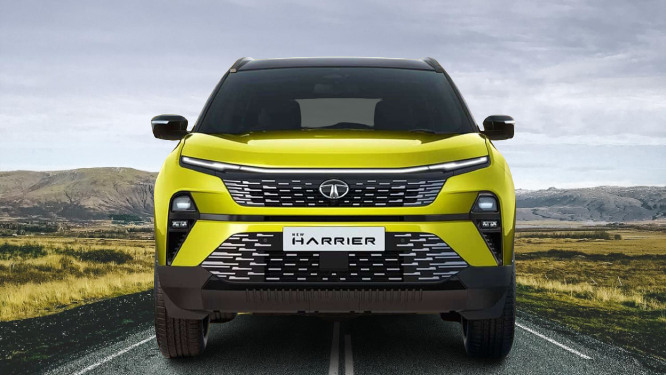The Tata Harrier has traversed a remarkable journey for Tata Motors. It began as an enticing concept and eventually rolled out with a diesel engine complemented by a manual gearbox. Subsequently, the Harrier received further enhancements, including new features and the introduction of an automatic transmission. Nevertheless, the latest iteration could be perceived as a near-total reinvention, boasting a fresh design, a particularly revamped interior, and an abundance of cutting-edge technology. It’s worth noting that the diesel engine remains the sole powerplant choice, and we had the opportunity to test drive the manual version.

Looks
This is where the Harrier truly excels, and its bold design takes you by surprise, marking a substantial departure from its predecessor. While it still retains the signature Harrier shape, it now embraces the fresh Tata design language, which draws inspiration from the Curvv concept and the new Nexon. The focal point of attention is the full-length LED light bar at the front, which commands a commanding presence. The grille design boasts a captivating and distinctive pattern, accompanied by a reshaped bumper, contributing to its distinctive and more aggressive appearance. Notably, the vibrant yellow shade adds a striking touch. The side profile remains largely unchanged, save for the distinct 18-inch alloy wheel design, while the rear showcases connected LED tail-lamps. The Harrier offers various color options to suit different tastes, but overall, the new Harrier represents a significant transformation, exuding a heightened sense of aggression.
Interiors
Upon swinging open the hefty doors, the interior of the Harrier unveils an even more substantial transformation compared to its predecessor. Virtually everything is brand new, from the four-spoke steering wheel adorned with an illuminated logo to the digital instrument cluster, complemented by a larger, more contemporary touchscreen display. The core shape of the center console remains consistent, but the quality has taken a significant leap forward. Notably, contrasting elements harmonize with the exterior color, adding a tasteful touch to the interior.
The star of the show is the expansive 10.25-inch digital instrument cluster, which offers customizable configurations, including a full map view through Android Auto and Apple CarPlay. The main touchscreen unit is now larger and impressively user-friendly, featuring a high-quality display and customizable widgets. Just beneath it lies the new touch control panel, reminiscent of the one found in the new Nexon, complete with two physical toggles. While it may attract fingerprints, the controls are intuitive and straightforward to use.
In terms of features, the Harrier boasts an extensive list that positions it among the most well-equipped SUVs in its class, even surpassing some entry-level luxury SUVs. The offerings include a crisp 360-degree camera system with front parking sensors, dual-powered seats with ventilation, dual-zone climate control, a voice-assisted panoramic sunroof with mood lighting, a blind-view monitor, and a gesture-controlled tailgate. Safety is prioritized with seven airbags. The Harrier also incorporates connected car technology, featuring built-in Alexa and support for voice commands in multiple languages. A standout feature is the 10-speaker JBL audio system, which offers 13 different sound modes, akin to high-end luxury vehicles. The sound quality is exceptional, and these modes significantly enhance the audio experience, further enhanced by tailored sound direction for each seat.
The gesture-controlled tailgate operates seamlessly, making daily use more convenient. These features collectively elevate the Harrier’s desirability. In terms of space, the rear seat offers excellent headroom and very generous legroom. However, the presence of a large central tunnel and the absence of a middle headrest limit the rear seating to four passengers. Nevertheless, the cabin feels incredibly spacious, especially with the expansive panoramic sunroof, and rear sunblinds add to the comfort and privacy.
Driving experience
In terms of powertrain, the 2.0-liter diesel engine continues its duty in the Harrier, delivering 170bhp and 350Nm of torque. During our test drive, we experienced the Harrier equipped with a 6-speed manual transmission, while the automatic version features a new shift-by-wire mechanism. The diesel powerplant retains its familiar characteristics, exhibiting some turbo lag, but it compensates with a robust torque output that results in impressive acceleration. Although the diesel engine remains slightly noisy, it cruises effortlessly.
Notably, the most impressive update comes in the form of the new 6-speed manual gearbox, which is now more user-friendly and provides smoother shifts. The clutch has also been lightened, enhancing the overall driving experience. However, the most significant enhancement lies in the new electric power steering, which replaces the heavy steering of the previous Harrier. It strikes a balance between being light and responsive, making maneuvering and parking more manageable. It feels direct and represents a substantial improvement.
Regarding the ride quality, the Harrier exhibits a slightly stiff ride at lower speeds, and it can transmit sharp road imperfections. However, the ride becomes notably better at higher speeds, offering good high-speed stability. The Land Rover platform demonstrates its robustness, and despite lacking 4×4 capability, it handles basic off-road challenges with confidence and toughness.
Efficiency has also seen a slight improvement, achieving nearly 17 kmpl at higher speeds. Tata Motors has integrated additional Advanced Driver Assistance Systems (ADAS) features, including Adaptive Cruise Control with stop/go functionality, emergency braking, collision warning, and blind spot detection. These features operate effectively, enhancing both safety and convenience during the drive.
Read Also :- Ratan Tata’s Tata Nano EV a Reality?
Verdict
Undoubtedly, the new Harrier represents a significant leap forward in almost every aspect, excelling particularly in key areas like design and the updated cabin. Its equipment roster now stands among the best in its class, and it maintains its reputation as a spacious SUV. The introduction of the lighter steering and the improved gearbox enhances the overall driving experience, making it notably more user-friendly.
Tata Motors has effectively addressed previous concerns, rendering the Harrier a considerably more appealing SUV that can contend with its rivals confidently. However, it would be even more enticing if it were available with a petrol engine. Nevertheless, all in all, this transformation marks a substantial change, and the Harrier now presents a highly compelling proposition for those in the market for an SUV.
What We Like:
- Striking Design
- Comprehensive Features
- Ample Space
- Comfortable Interior
- Robust Build Quality
What We Do Not Like:
- Lack of a Petrol Engine Option
- Firm Ride at Low Speeds

Owner & Author – Jammu Deals Automobile enthusiast and founder of Jammu Deals. Sharing trusted updates, tips, and insights on cars, bikes, and the latest in the auto world.
